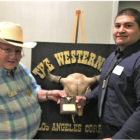Roundup: July 11, 2018
Our Speaker: Patrick Burtt, UCLA Graduate Scholar & Westerners Autry Fellow
His Subject: Challenging the Veracity of Gold Rush Era History in California & Nevada
Our speaker is an enrolled member of the Washoe Tribe of Nevada and California (Waší•šiw) and a direct descendent of the Tule River Tribe (Yokut). Mr. Burtt will describe a different perspective on history during the Gold Rush in California and the Nevada Comstock Lode (the Silver Rush). In American history, existing research on the Waší•šiw during that period is dominated by non-Waší•šiw perspectives. This has contributed to the erasure and erosion of the status of the Waší•šiw in United States history. His studies focus on including Waší•šiw perspectives and challenging the veracity of existing California and Nevada history, including white-washing of state-sanctioned genocide. In 1851, California’s last Governor as a territory and first Governor as a state, Peter H. Burnett said, “A war of extermination will continue to be waged between the two races until the Indian race becomes extinct.” The consequences of this thinking and the related actions persist to today.
The ancestral territory of the Waší•šiw encompasses the entirety of what is now referred to as Lake Tahoe and stretching north to Honey Lake, south to Sonora Pass, west to the Sierra Nevada Mountain foothills and east to the Pine Nut Mountains. Presently, the Waší•šiw are made up of approximately 1,550 enrolled tribal members, many located in four communities in what is now Nevada and California.
Patrick Burtt is the Westerners, Los Angeles Corral Autry Fellow for 2018. He recently received his Master of Arts in American Indian Studies at the University of California, Los Angeles (UCLA) and will continue his studies at the University of Nevada, Reno (UNR) towards a doctoral degree through the Department of History this fall. Burtt received a Bachelor of Arts in Native American and Indigenous Studies from Fort Lewis College. He was the Oral Histories Coordinator for a program at the Stewart Indian School by UNR. Patrick has done research for the Washoe Tribe Historic Preservation Office in Gardnerville, Nevada. He has presented papers and participated in panel discussions related to his research at various academic conferences such as the American Indian Studies Association’s Annual Conference. Patrick is currently preparing a report on hate crimes against American Indians for the American Indian Studies Center at UCLA.
Roundup Synopsis
Taken From Branding Iron 291 Summer 2018.
Our speaker at the July meeting was Patrick “Deʔileligi” Burtt, the Corral’s 2018 Fellow at the Autry National Center and a member of the Washoe tribe of Northern California and Western Nevada. In his presentation, “Waší∙šiw Genocide,” Burtt argued that the Washoe should be federally recognized as victims of genocide, defined by the 1948 United Nations Genocide Convention as “acts committed with intent to destroy, in whole or in part, a national, ethnic, racial, or religious group.”¹ While the Washoe were not victims of systematic mass murder like those of the worst crimes the 20th century, Burtt argued that 19thcentury California State policies nevertheless produced similar effects indirectly.
From the beginning of statehood, California law gave whites a “blank check” to victimize and exploit native peoples like the Washoe. One 1850 law disallowed Indians from testifying in court in cases involving white people. Another easily-abused policy fined Indians for “vagrancy” and auctioned off their labor to the highest bidder; once these Indians had worked off their debt, they were usually arrested and fined again, continuing the cycle of debt-servitude.
The majority of Burtt’s talk was devoted to a case study illustrating how such laws had deadly consequences. He recounted a Washoe oral history from Sarah Winnemucca Hopkins’ Life Among the Paiutes about the murders of two white men. The murderers, also white, jammed arrows into the bullet wounds to frame the crime on the local Washoe. News spread of the “Indian attack,” and an angry white mob demanded that the Washoe hand over the murderers. The Washoe men had all been at camp when the murders occurred, but the white men didn’t believe them. Knowing they had no legal recourse and that they could all be killed by the mob if they did not comply, the Washoe produced three volunteers who “confessed” to the deed. They were promptly lynched.
Due to policies and incidents like these, combined with Old World diseases, the Washoe pre-contact population declined from around 1500 at the beginning of the 19th century to less than 300 by 1907. To pursue the recognition of this demographic catastrophe as a genocide, Burtt intends to expand his research to the Autry Museum and the Nevada State Library and Archives. Federal recognition and restitution await more academic debate, and of course, a great deal of politics. The Westerners thank Mr. Burtt for his presentation and wish him luck in his efforts on behalf of the Washoe.
— Aaron Tate



